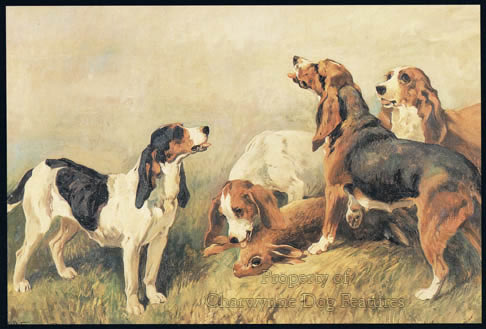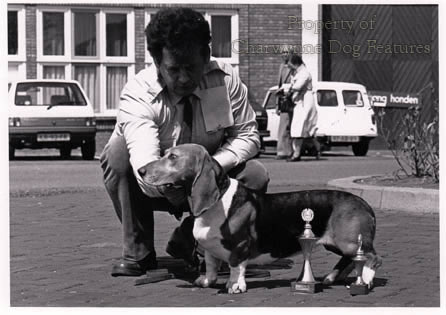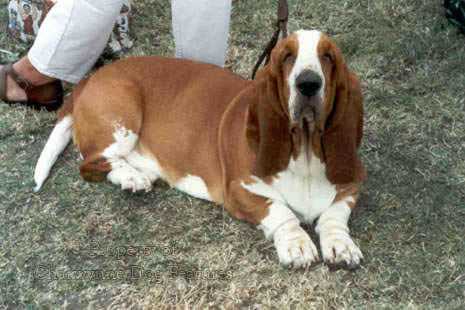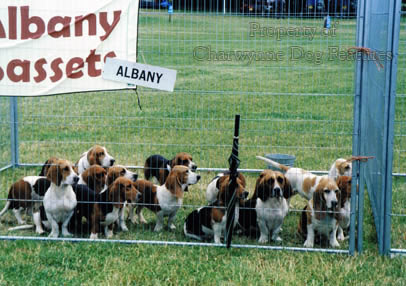55 RESTORING THE REAL BASSET
RESTORING THE REAL BASSET HOUND
by David Hancock
 "Long body, short legs, large back, long leathers, lovely head, lovely voice, the Basset is full of good qualities. It always has a loathing for any beast, but rabbit and hare are particularly favoured quarry; however Bassets are a perfect pure breed for roe deer, wolf and boar. Usually white with black or fawn markings, often their hair is all black and thick with reddish touches under the eyes, over the chest and at the base of legs. Many are griffons and amongst these, many are white with large patches of coffee colour. The other varieties of Basset are primarily distinguished by very pronounced arching of the front legs, their colour is the same as that of the straight legged Bassets; only I know that the griffons are very rare. The Bassets are naturally very much slower than the other hounds.”
"Long body, short legs, large back, long leathers, lovely head, lovely voice, the Basset is full of good qualities. It always has a loathing for any beast, but rabbit and hare are particularly favoured quarry; however Bassets are a perfect pure breed for roe deer, wolf and boar. Usually white with black or fawn markings, often their hair is all black and thick with reddish touches under the eyes, over the chest and at the base of legs. Many are griffons and amongst these, many are white with large patches of coffee colour. The other varieties of Basset are primarily distinguished by very pronounced arching of the front legs, their colour is the same as that of the straight legged Bassets; only I know that the griffons are very rare. The Bassets are naturally very much slower than the other hounds.”
From La Venerie Francaise by Le Comte le Couteulx de Canteleu, 1858.
The above quote is from the most famous French hound breeder of his time and his admiration for the Basset is quite clear. The breed we know best in Britain is outnumbered by those of mainland Europe, such as the Artesien-Normand, the Bleu de Gascogne, the Fauve de Bretagne and the Griffon-Vendeen Petit and Grand. They are still used to hunt hare and rabbit for the gun, excelling in dense cover. But they are also used for flushing game birds, rather like spaniels. There have been theories that the type evolved as a 'sport' from the St Hubert Hound, in its various types, and was then committed to a hunt involving footed rather than mounted hunters. We know that the short leg in the Bloodhound is dominant genetically over the longer leg (Whitney, How to Breed Dogs, Orange Judd, 1947). The short leg is a Basset feature, whether crooked or straight. A sporting writer, Pennell-Elmhurst, who wrote under the pseudonym Brooksby, is quoted in David Hindle’s The Hunting Basset of 2009, as writing, in 1896: “On Tuesday I had the opportunity of seeing a form of hunting altogether novel to me, viz., the chase of the hare by Basset Hounds, the Messrs Cooper having brought their pack from Delapre Abbey. I confess I was charmed. There was something so sporting in seeing these little hounds (to all appearance first cross between a turnspit and a foxhound) driving along in grass that almost hid them.” He likened their length of leg to the spit-turning dog as no other hound here displayed such a feature at that time. A wealthy London-based sportsman would not have been aware of the Welsh heelers with similar legs or the tendency for some working terriers to carry such a noticeable feature.
Early References
In his most valuable book on hunting, published in the late 16th century, Jacques du Fouilloux makes an early reference to Bassets, describing them as badger dogs. He identified two types: those with a crooked front, which he stated were short-coated and went to ground better, and those with a straight front, which often carried the rough coat and ran game above ground as well as conducting terrier work. Du Fouilloux attributed the first home of these Bassets to the regions of Artois and Flandres. Both these regions have a record over five centuries of producing exceptional hounds.
In his excellent book on The Basset Hound (Popular Dogs, 1968), George Johnston, who knew his hounds, produced a map of north-western Europe showing the distribution of the Basset type. This puts the rough-coated variety in north-west France (the Basset Fauve de Bretagne and the Basset Griffon-Vendeen), the smooth-coated variety in the north (the Bassets de Normandie, d'Artois and d'Ardennes) and the south (the Bassets de Saintonge and Bleu de Gascogne), with some smooth-coats on the German-French border in the Vosges and the Black Forest. He also mentions the allied breeds: the Dachshund in Germany, the Niederlaufhund of Switzerland and the Drever of Sweden.
The first French dog show, in Paris in 1863, issued a catalogue which listed Bassets as follows: straight-legged short and long-haired, crooked-legged short and long-haired, Baden Bassets, Burgos, St Domingo, Illyrian and Hungarian Bassets. This shows a Basset diaspora stretching from Brittany to Budapest and from the Black Forest to the Balkans. The Baden Basset would have been the Dachsbracke or badger hound. The Danes had a Dachsbracke too, known there as the Strellufstover, and now embraced by the Drever of northern Scandinavia. These short-legged but usually straight-legged hounds were used to drive game to the waiting guns. It is surprising that, whilst the Swiss have developed several breeds of Niederlaufhunde, the French border areas with Switzerland have none.
The Companion Basset
The Basset Hound had a chequered start as a hunting dog in Britain. As Dr Brian Wilson points out in his A Bother of Bassets of 2004; throughout Britain, over 30 Basset Hound kennels which had begun to operate between 1872 and 1903, had, by the time the Master of Basset Hounds Association (MBHA) was founded in 1912, come and gone. But the Basset Hound, as a pet or show dog, is now well established in Britain, with over 1000 being registered annually. In America in 1977, nearly 15,000 were registered with the AKC, such was their appeal. Other French Basset breeds are now becoming known here, with the Petit Basset Griffon Vendeen proving the most popular. Thirty years ago, I found them longer-eared, longer-backed and more heavily-coated than desired, but this may have been due to the breeding between the Grands and the Petits allowed up till then. This is hardly surprising for it is a delightful breed, full of character and charm. A first class book on the breed has recently been published: written by Valerie Link and Linda Skerritt, and published in America by Doral Publishing. Nearly 400 pages long, with a good index, it is a pleasing production in times when so many breed books are disappointingly shallow. The best show Basset Hound, of all the Basset breeds, that I saw in 2012 was a Petit Basset Griffon Vendeen bitch, Champion Soletrader Peek A Boo, bred by Gavin and Sara Robertson and sired by a Dutch import, also from Soletrader kennels’ stock. This hound really looked as though she could hunt! (Afternote: she won Best-in-Show at Crufts in 2013).
It is ironic that those with show Bassets who criticize the hunting fraternity for their outcross to the Harrier should choose to overlook pioneer breeder Millais's outcrosses to both the Beagle and the Bloodhound. Of this latter cross, as documented by David Hindle in his The Hunting Basset of 2009, Millais stated, at the time (c. 1892): “I therefore employed the Bloodhound as the vehicle for importing fresh blood to counteract the commencing degeneration on the part of the Basset, considering that this cross would be of infinitely greater value to us breeders than the importation would be of a number of French Bassets of the same variety, but of inferior type and size.” It’s the task of any hound breeder to improve his hounds not just perpetuate old flaws. Pure-bred Bassets are still represented in the hunting field by the Albany and the Huckworthy. Ten years ago the West Lodge pack was ¾ Basset, ¼ Harrier but there were also Griffon-Vendeens in the pack. There are several packs of Petit Griffons-Vendeens hunting in Britain. The Ryford Chase has utilised West Country Harrier, Welsh Foxhound and more recently Beagle blood to make the pack less wilful and more biddable.
The Albany was for some time the Basset Hound Club's pack, with some show dogs hunting with them. The American hunting Bassets are often show dogs too. American hunters find two types of Basset Hound: those with high energy, which are lighter in bone, less chunky and longer in leg and the lower energy, more classic hounds which are noticeably more laid-back, in the modern idiom. The former lack the painstaking methodical style of the classic Basset hunt but often 'hunt on' using air scent before picking up ground scent once more. The Americans have trials for hunting in packs and hunting in couples or brace trials. The American Rabbit Hound Association also has a hunt competition for Bassets. In the future we may well have no Bassets hunting..jpg)
The Hunting Packs
In 1908 there were nearly forty hunting packs of Bassets in Britain, against just 10 Basset Hounds registered with the Kennel Club in that year. Twelve years ago there were ten packs recognized by the MBHA: six were straight-legged packs, the others crooked-legged. About half were pure-bred Bassets, the remainder mainly the so-called English Basset, the progeny of the Harrier outcross and more recently Beagle, West Country Harrier and Petit Basset Griffon Vendeen blood too. The first pack made up of English Bassets was the Westerby, whose country lies mainly in Leicestershire, and originally pure-bred Walhampton Bassets. The pure-bred hunting basset lacks much of the excessive wrinkle and exaggerated crooked knee of so many show bench hounds. The Fourshire Bassets of ten years ago were good examples of pure-bred working hounds.
Around 1910, the hunting stock declined appreciably, all too many of the hounds displaying gross exaggeration and even malformation. There were stories of Bassets being carried from the hunting field on stretchers made of sheep hurdles. In 1911 the MBHA was formed and only hounds from recognized packs became eligible for registration. KC-registered hounds were refused entry. The majority of MBHA registrations were Artesien-Normandie in origin. A notable exception was the Sandringham kennel of Basset Griffon-Vendeen owned by Queen Alexandria. But the First World War almost saw the demise of the Basset Hound in England.
Colonel Morrison's work with the Westerby pack from the 1930s saw a steady improvement in fortune. He started with the Basset Artesien-Normandie for its nose and cry, that is, its scenting skill and musical baying. He made inspired crosses with the Basset Griffon-Vendeen, the Beagle and the Harrier to enhance drive, stamina and pace. Today's show breeders should note that the improved performance was not vaguely 'expected' from a closed gene pool but pursued by a gifted breeder with an open mind. Millais, the pioneer Basset breeder would have approved.
Lesson worth Heeding
The desire to see hounds bred for hunting led to the Albany & West Lodge Hounds pack being formed in 1955, as the Working Branch of the Basset Hound Club (BHC). In 1972, the name of the pack was changed to just the Albany and the Working Branch restructured. In 2002, the BHC withdrew support for the Albany when the latter felt the hounds were becoming too heavy and cumbersome. The Albany became a subscription pack and began to outcross to other packs in the pursuit of a working capability in their hounds. Foxhound, Harrier or Beagle blood was never used in these outcrosses. In 2006, the Albany merged with the West Lodge, seeking hounds that could hunt for four hours, twice a week. A working hound with its chest at least five inches off the ground was the aim. This parting of the ways can never be good for the breed and is a lesson to be heeded by other hound breed clubs wanting to develop a pedigree breed still able to perform its original function. Could it be that in the Basset Hound of the show rings the long-ago Bloodhound input is proving, even today, too dominant genetically for this breed’s best interests, guilty of introducing exaggerations to an unhealthy degree?
Avoiding Excessive Features
A writer in the Veterinary Record in 1991, referred to this type, rather unkindly, as 'achondroplasic dwarfs'. Smythe, in his excellent The Conformation of the Dog (Popular Dogs, 1957), writes: "Some breeds exhibit localized deformities; in the Dachshund and Basset Hound the head and body are normal but the limbs show exaggerated achondroplasia. Legs are short, thick and somewhat crooked. Both the head and the limbs are encased in a skin several sizes too large for the dog, with wrinkled folds. The feet are large." Achondroplasia is a form of dwarfing due to disease affecting the long bones of the limbs before birth; it occurs in cattle and in other breeds of dog. When it is undesired in a breed of dog, the afflicted pups are quickly destroyed.
The inheritance of short legs is complex; Robinson in his Genetics for Dog Breeders of 1989, suggested that shorter legs are dominant over longer legs. He went on to state: "Although polygenic heredity may be assumed for length for most breed differences, this does not mean that major achondroplasic genes do not exist." The worry here for me is that shorter-legged breeds can in time become even shorter and not always for the benefit of the breed. Crooked legs can so easily become painfully crooked legs. It is significant that when the Bassets used for hunting in Britain became too exaggerated, it was the leggier Harrier which provided the best outcross, rather than the Beagle, which was also tried. I believe that Basset Hounds, pure-bred and true to type, in France, Britain and America, have occasionally produced a large hound pup, with straight proportionately long legs, in an other wise typical Basset litter. Significantly, the Basset Fauve de Bretagne is only allowed a ‘slight crook’ in its front legs. It is also the shortest-backed Basset breed. Some of the breed here have passed the schweisshund aptitude test – a tribute to their soundness.
Showing Limitations
If you respect and admire functional dogs then it is with sadness that you might view some Bassets on the show bench. There is all too often a poor lay of shoulder, a short upper arm, a looseness of elbow, flat feet or even splay-feet and a lack of a ribcage carried well back. Even more apparent are the over-long ears and the over-bent front legs. A cynic might observe that the Basset Hound is a breed much loved by the nation but not so much by some of its breeders. There is a balance to be found in such a breed between breed type and a degree of gross exaggeration that causes discomfort to the dog. Breed lovers should be dog lovers too. It is worrying to read a show critique by an experienced well-regarded judge at a top championship show in 2012 containing remarks such as: “I was very surprised at the poor quality…at this show. Too many upright shoulders…flat large heavy ears...eyelids not in contact with the eye…Some were too heavy and close to the ground and were unable to move with any purpose.” An event like this should show-case the breed, not provide ammunition for the anti-showdog brigade.
It was reassuring to read the critique of the Basset Hound judge at Crufts 2013, which included these valuable observations: “…my overall impression was that the huge, overdone Basset, dripping in furnishing and confusing weight with substance was on the wane which can only be a good thing. However breeders must not overlook the less overt faults such as flanged and slab-sided ribs, forward shoulders, incorrect bites and most importantly eyes, all of which are both wrong and debilitating, in favour of what appears, from the ringside, to be improvements.” Such informed and outspoken honesty can only be good for this appealing little breed. So often show critiques seem worded to please the exhibitors and not to benefit the breed itself.
Such an admirable breed should not need protection from its top breeders. The breed elders have much to do if this distinctive breed is to remain healthy and retain both type and public affection. It is refreshing when experienced knowledgeable Basset Hound breeder/owners speak out and voice their disquiet. A decade ago, Vivien Evans, the wife of the late John Evans, who did so much for the Basset Hound Club and was a key figure in the setting-up of the Albany Basset pack, put forward the view that in today’s show rings, we see too many heavyweight parodies of the true hound and they often win awards! She considered that many breeders had reinterpreted the words of the breed standard in order to produce excessively heavy creatures quite unsuited to their original purpose. She argued for a weight limit and the making of soundness the prime consideration for ring success. She pleaded for the breed to be saved from the excesses of those who claim to love it. For the sake of this most distinctive of hound breeds, I do hope her wise words are heeded.
“To the Editor of the Kennel Gazette,
Sir, BASSETHOUNDS, Would the exhibitors of the above hounds pardon my ignorance, and kindly inform me whether the bassethounds as exhibited at the late Kennel Club show are intended to be used as ‘sporting dogs’, in which category I see they are classed, or if they appeared as an advertisement for hounds fatted for show purposes, and as such, no doubt, splendid specimens? Being of a ‘sporting’ turn of mind I thought I should like to possess a small pack of these dogs, but the appearance of those at the show has quite damped my ardour, as for hunting purposes those dogs could only be of use to one afflicted with the gout, or otherwise incapacitated from the active use of his legs.”
From The Kennel Gazette, March, 1888.
The sentiments could have been expressed by a sportsman of today; but The Kennel Gazette of today would not print such a letter – any criticism of the pedigree dog is forbidden in this journal. I wrote articles for it for five years, then dared to express a view, in another magazine, that opposed KC thinking at that time, and was never to write for them again. Sycophancy or blind loyalty can never be in the best interests of dogs.